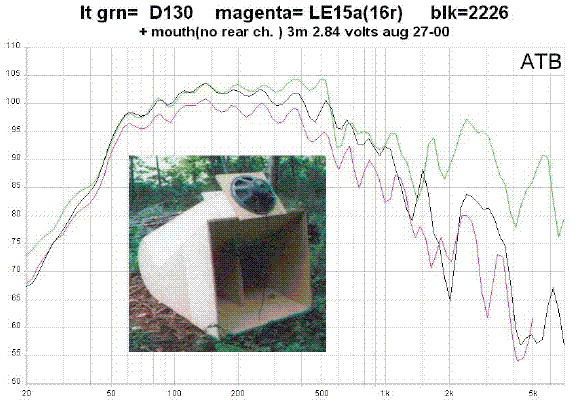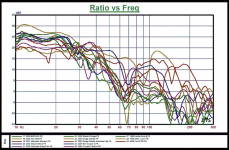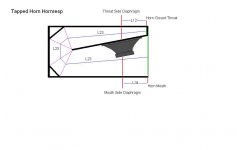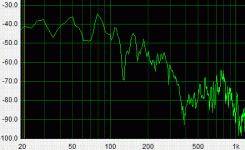Actually, the "bass bosst" he mentiones is the interesting part.... The room gain in a Car is massive and increases to lower frequencies. Somewhere someone posted a measurement (I guess it was done by JBL, if I recall correctly) of different cars. It showed very nicely, that cars behave differently but all showed very high boost levels.
Ah, found it on my hardrive
IMHO it´s not important how you look at the sim (if 1/8 space, 1/4, etc..), because the correspondnig space is nothing else then considering the attached walls to the speaker.... As a attached wall acts as an accoustic mirror, it raises the SPL of the speaker. So actually, the "boost" curve just would be different when using different spaces in simulation... LSPCad is able to do some simulation like this, akabak can also help. LEAP shoud do the trick also.
Ah, found it on my hardrive
IMHO it´s not important how you look at the sim (if 1/8 space, 1/4, etc..), because the correspondnig space is nothing else then considering the attached walls to the speaker.... As a attached wall acts as an accoustic mirror, it raises the SPL of the speaker. So actually, the "boost" curve just would be different when using different spaces in simulation... LSPCad is able to do some simulation like this, akabak can also help. LEAP shoud do the trick also.
Attachments
"- EBP fairly low (so "typical" hornusage is not recommended (when refering to the classic recommendation of high EBP)). "
EBP is only important as far as taking this number times two gives the mass corner for the driver for horn use.
The mass corner is important in choosing the driver as you want to pick the LOWEST mass corner that has adequate bandwidth for your application.
For example: you want a bass horn that will not be used above 100hz. Using a driver with a mass corner of 400hz will give no higher efficiency (below 100hz) than a driver with a mass corner of 100hz. For typical drivers, the 100hz mass corner driver will have 4x the x-max than the 400hz driver, and thus 12dB more maximum output capability.
The mass corner on the Z3 driver is about 166hz, compared to the 112hz for the Eminence Lab 12.

(data from Bill Woods)
Note how all three drivers have essentially the same response below 200hz (remember to add 3dB to the 16R driver curve). The mass corners on these drivers vary from about 180hz to just over 400hz.
EBP is only important as far as taking this number times two gives the mass corner for the driver for horn use.
The mass corner is important in choosing the driver as you want to pick the LOWEST mass corner that has adequate bandwidth for your application.
For example: you want a bass horn that will not be used above 100hz. Using a driver with a mass corner of 400hz will give no higher efficiency (below 100hz) than a driver with a mass corner of 100hz. For typical drivers, the 100hz mass corner driver will have 4x the x-max than the 400hz driver, and thus 12dB more maximum output capability.
The mass corner on the Z3 driver is about 166hz, compared to the 112hz for the Eminence Lab 12.

(data from Bill Woods)
Note how all three drivers have essentially the same response below 200hz (remember to add 3dB to the 16R driver curve). The mass corners on these drivers vary from about 180hz to just over 400hz.
Of course, thanx for the addition 
That´s why I wrote "when refering to the classic recommendation of high EBP" There are a lot of classical advices floating around in the Speaker-universe which are sometimes obsolete or are "old rules". After all, the research on speakers is far from perfekt, many rules of thumb are just guesses or are derrived from empirical trial & error. It´s like saying: A Qts of 0,39 is prefect for a reflex enclosure... I´ve heard and build tons of speakers where this rule wasn´t respected and they worked great... One just hast to take a look at some recent designs beeing developed with Ajhorn or tapped horns - many old rules don´t apply here any more.
There are a lot of classical advices floating around in the Speaker-universe which are sometimes obsolete or are "old rules". After all, the research on speakers is far from perfekt, many rules of thumb are just guesses or are derrived from empirical trial & error. It´s like saying: A Qts of 0,39 is prefect for a reflex enclosure... I´ve heard and build tons of speakers where this rule wasn´t respected and they worked great... One just hast to take a look at some recent designs beeing developed with Ajhorn or tapped horns - many old rules don´t apply here any more.
That´s why I wrote "when refering to the classic recommendation of high EBP"
Sabbelbacke said:Actually, the "bass bosst" he mentiones is the interesting part.... The room gain in a Car is massive and increases to lower frequencies. Somewhere someone posted a measurement (I guess it was done by JBL, if I recall correctly) of different cars. It showed very nicely, that cars behave differently but all showed very high boost levels.
Ah, found it on my hardrive
IMHO it´s not important how you look at the sim (if 1/8 space, 1/4, etc..), because the correspondnig space is nothing else then considering the attached walls to the speaker.... As a attached wall acts as an accoustic mirror, it raises the SPL of the speaker. So actually, the "boost" curve just would be different when using different spaces in simulation... LSPCad is able to do some simulation like this, akabak can also help. LEAP shoud do the trick also.
thanks for the trick!
djk said:"- EBP fairly low (so "typical" hornusage is not recommended (when refering to the classic recommendation of high EBP)). "
EBP is only important as far as taking this number times two gives the mass corner for the driver for horn use.
The mass corner is important in choosing the driver as you want to pick the LOWEST mass corner that has adequate bandwidth for your application.
For example: you want a bass horn that will not be used above 100hz. Using a driver with a mass corner of 400hz will give no higher efficiency (below 100hz) than a driver with a mass corner of 100hz. For typical drivers, the 100hz mass corner driver will have 4x the x-max than the 400hz driver, and thus 12dB more maximum output capability.
The mass corner on the Z3 driver is about 166hz, compared to the 112hz for the Eminence Lab 12.

(data from Bill Woods)
Note how all three drivers have essentially the same response below 200hz (remember to add 3dB to the 16R driver curve). The mass corners on these drivers vary from about 180hz to just over 400hz.
great! thank you for the addiction!
ps good realisation (photo), expeccially for pa!
zobsky said:In a TH modelled in Horn resp with sections S1-S2, S2-S3, S3-S4, is the vent situated at S3 or S4? I know the driver is exposed to the horn at S2 and S3 .. but where's the vent situated at ?.
Hi zobsky,
Have you read Note 8 on page 16 of the Hornresp Help file?
Kind regards,
David
Hi Dave,David McBean said:
Hi zobsky,
Have you read Note 8 on page 16 of the Hornresp Help file?
Kind regards,
David
Yes I did read that a while back. It doesn't say where the horn vents to the outside. I'd normally assume this to be at S4 (the mouth), but wasn't sure (mainly because I built one with the vent at S3 ).
Thanks
1. Order (6dB) ist not much, usually you need a higher order (depending on what you want to do, which tops to add, etc..). Do you have an active crossover? Realising a good working passive crossover at these low frequencies is veery expensive and doesn´t give goo results.
Hey, I'm trying to get what I need to measure my tapped horns (and do RTA) for christmas. I already have a capable laptop PC, but what else will I need to get in order to be able to do RTA and measure the tapped horns?
Here is a tread i started on the matter.
http://www.diyaudio.com/forums/showthread.php?s=&threadid=134816
Here is a tread i started on the matter.
http://www.diyaudio.com/forums/showthread.php?s=&threadid=134816
Of course you will want a microphone. I think it is best if it can do a line level output because I don't like calibrating the levals on my computer and it's noisy when I do.
I think you need lots of cables. 1/8 stereo to RCAs (long ones) to feed your amp, same for your microphone, 1/8 stereo at each end to calibrate your computer by plugging it back into itself. If you want to do other measurements you might have to plug one channel back into itself and the other output to your amp and the other input to your microphone so make sure you have M-F adapters and stuff like that.
I think you need lots of cables. 1/8 stereo to RCAs (long ones) to feed your amp, same for your microphone, 1/8 stereo at each end to calibrate your computer by plugging it back into itself. If you want to do other measurements you might have to plug one channel back into itself and the other output to your amp and the other input to your microphone so make sure you have M-F adapters and stuff like that.
First you have to decide if it´s really a good idea to RTA your TH..... After all, in bass you have all kinds of room-acoustics effects which can´t be delt with by simply EQing the sound. And even if you do, using Standard-IIR Filter methods introduces a lot of phase problems (group delay)... Many Subs sound good without eqing, even if they don´t have a straight frequency response. After straightenig it, they sound awfull....
But if you decide to go for it, you need a calibrated system, especially in the low-frequency domain (most measuring mices are ok around 1k Hz, but at the low-end you really need something acourate). It doesn´t have to be the most expensive, a Behringer ECM8000 does perform ok, but you need to have it calibrated. Earthworks has some very nice mics including the pre-amplifier. If you have enough money, go for theses.... A little more affordable are the products from linear-x. Other measuerement-mics are avialable, too, but I don´t know if they are available in the US. I´d guess taking a look into the ads of "speaker builder" should give you some adresses. Beyerdynamik, Haun, Sennheiser, B&K - all make good measurement mics.
Then of course you need a good pre-amplifier (unless you buy a mic which already has one). Don´t know about the ones in the states, on europe monacor sells a cheap one which is ok. instead of buing a specialized one, a used Behringer Ultracurve could be usefull, since it has a linear pre-amp built in and a simple RTA Feature to play around.. After all, your setup needs to be calibrated, so it doesn´t really matter if the pre-amp ist the most linear one...
Next there is the software you need and not to forget the literature. Doing Audio-measurement ist a science of it´s own. Get Jo d'Appolito´s Book on audio-measruements, you´ll find all you need right there. A nice start for room-correction to play around might be the "room eq wizard" which is a java program you can use to do measurements and even feed a parametric equalizer with the results for bass-EQ (e.g. Behringer DSP 1124). For "real" measurments, probably the best value for the money right know is ARTA , if you are looking at the soundcard-based PC-Systems. Of course, you need a good Souncard here, too. An M-Audio Audiophile 2496 should be available worldwide and delivers a good performance for a fair price and is accurate enough for speaker-measruements without calibration. Of course, Systems like MLSA, linear-X, DAAS, etc... are well suited for the task but are more expensive... Speaker workshop is free and also can be used for speaker builders. For advanced analysis under linux, take a look at baudline (this is a very nice peace of software especially for analysis. Soleyl for speaker development, it´s just a gimmik).
There is so much more to this.... I´d advise to buy d'appolito´s book first to get a glimpse on how this stuff works.... Many people buy those simple measurement kids incl. Mics and Software... This is nice to play around, but the results are far from useful. The same could be achieved with a panasonic mic-capsule für 1$ in a aluminium-pipe, a pre-amp-mic-kit and some freeware... And this won´t really help in getting accourate measurements.
But if you decide to go for it, you need a calibrated system, especially in the low-frequency domain (most measuring mices are ok around 1k Hz, but at the low-end you really need something acourate). It doesn´t have to be the most expensive, a Behringer ECM8000 does perform ok, but you need to have it calibrated. Earthworks has some very nice mics including the pre-amplifier. If you have enough money, go for theses.... A little more affordable are the products from linear-x. Other measuerement-mics are avialable, too, but I don´t know if they are available in the US. I´d guess taking a look into the ads of "speaker builder" should give you some adresses. Beyerdynamik, Haun, Sennheiser, B&K - all make good measurement mics.
Then of course you need a good pre-amplifier (unless you buy a mic which already has one). Don´t know about the ones in the states, on europe monacor sells a cheap one which is ok. instead of buing a specialized one, a used Behringer Ultracurve could be usefull, since it has a linear pre-amp built in and a simple RTA Feature to play around.. After all, your setup needs to be calibrated, so it doesn´t really matter if the pre-amp ist the most linear one...
Next there is the software you need and not to forget the literature. Doing Audio-measurement ist a science of it´s own. Get Jo d'Appolito´s Book on audio-measruements, you´ll find all you need right there. A nice start for room-correction to play around might be the "room eq wizard" which is a java program you can use to do measurements and even feed a parametric equalizer with the results for bass-EQ (e.g. Behringer DSP 1124). For "real" measurments, probably the best value for the money right know is ARTA , if you are looking at the soundcard-based PC-Systems. Of course, you need a good Souncard here, too. An M-Audio Audiophile 2496 should be available worldwide and delivers a good performance for a fair price and is accurate enough for speaker-measruements without calibration. Of course, Systems like MLSA, linear-X, DAAS, etc... are well suited for the task but are more expensive... Speaker workshop is free and also can be used for speaker builders. For advanced analysis under linux, take a look at baudline (this is a very nice peace of software especially for analysis. Soleyl for speaker development, it´s just a gimmik).
There is so much more to this.... I´d advise to buy d'appolito´s book first to get a glimpse on how this stuff works.... Many people buy those simple measurement kids incl. Mics and Software... This is nice to play around, but the results are far from useful. The same could be achieved with a panasonic mic-capsule für 1$ in a aluminium-pipe, a pre-amp-mic-kit and some freeware... And this won´t really help in getting accourate measurements.
I test my boxes a few different ways.
I use the RTA to get a sense of what's going on overall
I use a Laboratory oscillator to see in detail what is happening in a cabinet and to find phase and notch issues not shown by the rta. I also use both the 1w 1m and Danley's 100w 10M.
The rta gives me average, the osccillator gives me pure specifics.
The 1w 1m gives me an idea of what the box is trying to do.
This way when I go to 10m I have an idea what issues to expect
that may not be room related.
I also look at what the port or horn (in a tapped) is doing versus combined response. I'll block off the horn section in a tapped to see what the direct radiator is actually doing to help determine cancellations or other issues.
Cheers
I use the RTA to get a sense of what's going on overall
I use a Laboratory oscillator to see in detail what is happening in a cabinet and to find phase and notch issues not shown by the rta. I also use both the 1w 1m and Danley's 100w 10M.
The rta gives me average, the osccillator gives me pure specifics.
The 1w 1m gives me an idea of what the box is trying to do.
This way when I go to 10m I have an idea what issues to expect
that may not be room related.
I also look at what the port or horn (in a tapped) is doing versus combined response. I'll block off the horn section in a tapped to see what the direct radiator is actually doing to help determine cancellations or other issues.
Cheers
Need Specs for TH
I am new to the site, and new to much of this lingo. I believe that a TH design would work best for the type of bass I am hoping to achieve. I am an avid woodworker with a full cabinet shop in the basement, so complexity of design is a good thing for me. I have a couple of drivers laying around that I would like to experiment with (one per box). They are car subwoofers, so I am not sure they will give me the quality that I would hope for - maybe you guys can comment. They are pretty rugged looking DVC (2 ohm / 8 ohm) 10" woofers with the following specifications:
Model CVR10
SPL 1W/1M 85.6dB
Displacement, cc 982.3
Displacement, cu in 75.3
Hole cutout, in. dia. 9-5/32
Mounting Depth, in. 5-7/16
Revc 7.75 Ohms
Sd, SqM .0379
BL, TM 17.65
Vas, Liters 40.40
Vas, CuFt. 1.42
Mms, gms 116.29
Fs, Hz 33.1
Qms 8.703
Qes .603
Qts .564
Pmax, watts 300
Xmax, mm 11.5
Freq Response, Hz 25-500
Magnet weight, oz 43
Voice coil (Kapton), In. 2
I am looking for some guidance on a folded tapped horn design which will present these speakers in their best light. If you think they are not a good match, plese say so. I might need a small crash course on what your software outputs actually mean. I am looking for dimensions that I can translate into pieces of wood. If you have a predicted Freq/SPL chart, that would be nice to see as well.
Thanks in advance,
Mike
I am new to the site, and new to much of this lingo. I believe that a TH design would work best for the type of bass I am hoping to achieve. I am an avid woodworker with a full cabinet shop in the basement, so complexity of design is a good thing for me. I have a couple of drivers laying around that I would like to experiment with (one per box). They are car subwoofers, so I am not sure they will give me the quality that I would hope for - maybe you guys can comment. They are pretty rugged looking DVC (2 ohm / 8 ohm) 10" woofers with the following specifications:
Model CVR10
SPL 1W/1M 85.6dB
Displacement, cc 982.3
Displacement, cu in 75.3
Hole cutout, in. dia. 9-5/32
Mounting Depth, in. 5-7/16
Revc 7.75 Ohms
Sd, SqM .0379
BL, TM 17.65
Vas, Liters 40.40
Vas, CuFt. 1.42
Mms, gms 116.29
Fs, Hz 33.1
Qms 8.703
Qes .603
Qts .564
Pmax, watts 300
Xmax, mm 11.5
Freq Response, Hz 25-500
Magnet weight, oz 43
Voice coil (Kapton), In. 2
I am looking for some guidance on a folded tapped horn design which will present these speakers in their best light. If you think they are not a good match, plese say so. I might need a small crash course on what your software outputs actually mean. I am looking for dimensions that I can translate into pieces of wood. If you have a predicted Freq/SPL chart, that would be nice to see as well.
Thanks in advance,
Mike
mtpotter
Go here and download Hornresp Hornresp Set Ang to 2 Pi
EG to 2.83 for the 8 ohm driver less for the 2 for 4 and ? for 2 ohm - look that voltage for 1 watt)
Rg = .1
These next will be changed but just to get you started:
S1 78
S2 578
S3 1021
S4 1068
Con 1 .1
Con 2 392
Con 3 35
Click on the Nd (under Re) until it reads TH
Input your speakers specs
Hit calculate.
Go to Window>Input Paramters
the Tools > Tapped Horn Wizard and play around and learn Hornresp. Wont take you long and you will find out if your dirver is good or not.
Go here and download Hornresp Hornresp Set Ang to 2 Pi
EG to 2.83 for the 8 ohm driver less for the 2 for 4 and ? for 2 ohm - look that voltage for 1 watt)
Rg = .1
These next will be changed but just to get you started:
S1 78
S2 578
S3 1021
S4 1068
Con 1 .1
Con 2 392
Con 3 35
Click on the Nd (under Re) until it reads TH
Input your speakers specs
Hit calculate.
Go to Window>Input Paramters
the Tools > Tapped Horn Wizard and play around and learn Hornresp. Wont take you long and you will find out if your dirver is good or not.
- Home
- Loudspeakers
- Subwoofers
- Collaborative Tapped horn project


